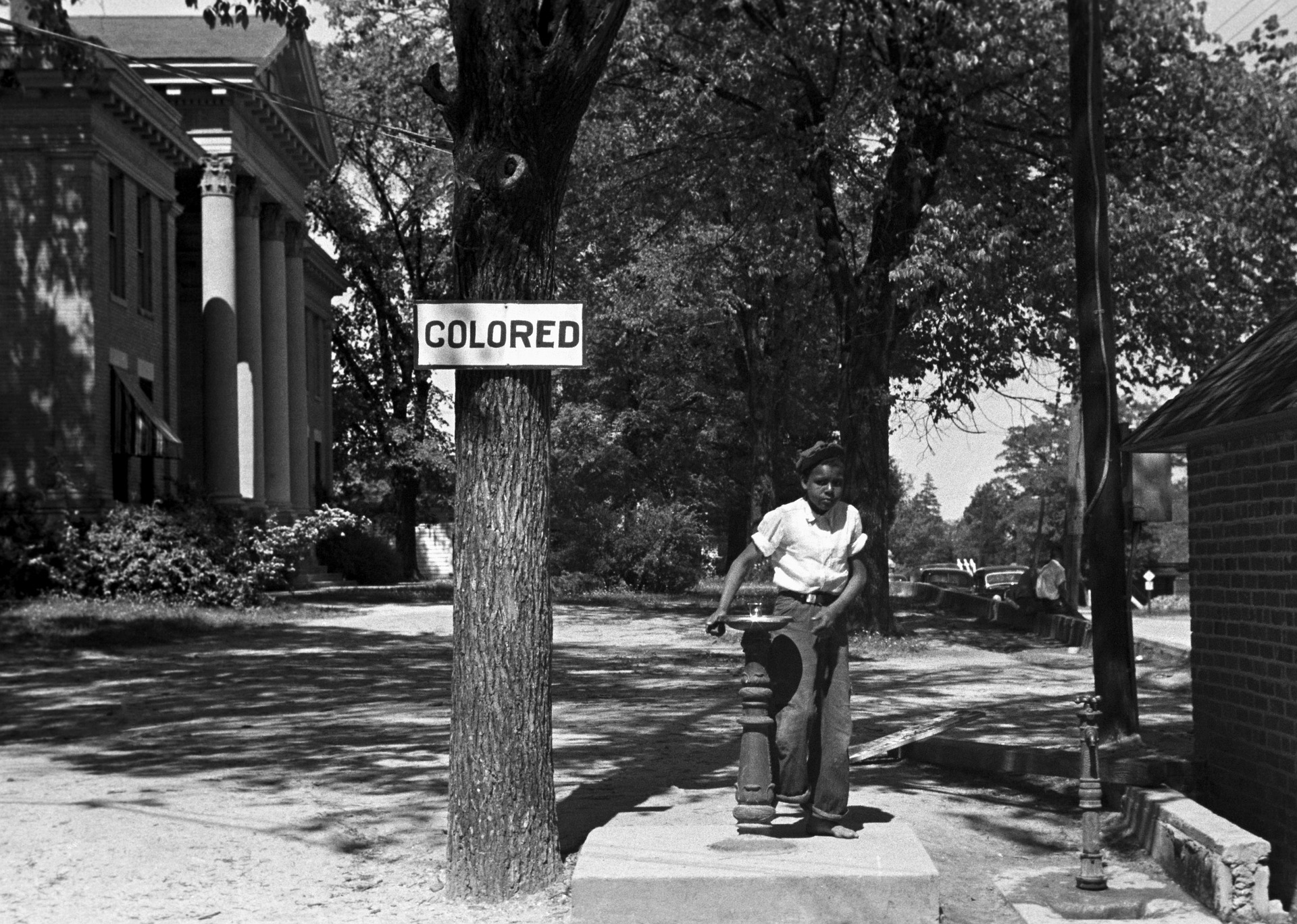“Revolution is not a one-time event.” – Audre Lourde
Less than 100 years ago, my parents attended and graduated from the same racially and culturally segregated American school system as their parents and grandparents.
The issue of race is one that consistently twists and torments the American social and cultural psyche with education being just one area of contention. Over 100 years after the first complaints over racial separation in education, the legal battle seemed to divide the matter.

An African-American child stands beside a water fountain marked with a sign that says “COLORED” [Pixabay]
A variety of United States Supreme Court decisions, ranging from the 1896 “separate, but equal” Plessy v. Ferguson case to the more commonly known 1954 Brown v. Board of Education in Topeka to the minor cases that address racial distribution such as the 2007 PICS case covering the states of Washington and Kentucky all took steps to resolve the issue of racial separation in education. While Brown v. Board of Education in Topeka provides a legal dividing line between the before of racial educational segregation, and the after of legal educational desegregation, the PICS case emphasizes how even over 50 years later segregation is still an issue. It is just one historical marker of how viewing situations before and after are not quite finished.
Often when we have important events such as the continued COVID-19 pandemic outbreaks, the recent verdict in the Derek Chauvin case for the murder of George Floyd, and the impending recovery in various parts of the globe from the 2020 economic shutdown, we see them as before – and after. We teach history as a subject in schools to emphasize what a specific sub-set of a dominant society deems important to know. The problems arise when we disagree on what remains critical as historical facts over time, thus falling into a neglect or forgetting of past events that shaped the very society that currently exists.
To learn, reflect, and grow means seeing how many issues are not resolved in one sitting or one point in history. Educational segregation and desecration are one such example. This is a fight that has existed for the entirety of our country’s history. While many recall the start of our nation with the date of July 4, 1776 as the official birth date of our nation, the inequalities do not have such as spotlight on their existence.
Every now and then a social or cultural battle, or even a literal one such as the Civil War will provide an extended time of historical movement. The key is to whether society and individuals let these occurrences disappear as just quick points in history or whether they continue to inspire current and future generations to remain vigilant and to take action.

Bottles labeled as COVID-19 vaccine [Pixabay]
The current COVID-19 pandemic has a before, after, and still for countries with increasing numbers of the fully vaccinated versus those with little or no access to vaccines. Wealth inequality in the form of life-saving COVID-19 vaccines shines brightly across the globe. While Americans have the luxury of three vaccines with some segments of the population seeing the choice to vaccinate or not as a personal choice, India drowns in cases, with inadequate means to protect its population, to treat the ill in hospitals, or even to conduct death rites with the dignity they deserve. The dead do not need to lay on pallets outside in a line due to an inability to burn bodies fast enough. The ill do not need to be treated in cars or on trains or by relatives due to a lack of space in local hospitals or even oxygen to treat those who are in the hospital.
Before the arrival of COVID-19 to the world stage, health inequalities remained in the realm of committee discussions or news items about humanitarian crises around the globe. Individual countries chose what to prioritize for their citizens, with infrequent outcries from other nations. After March 2020, the realities of the global pandemic forced countries to work together as viruses do not respect artificial political boundaries. While there may be disagreements as to the start of the pandemic, there is only agreement that certain measures could be taken in lieu of a vaccine: physical distancing from others, consistent and proper hand washing technique usage, and the wearing of face masks.
Some countries that chose extended lock-down periods with 100 percent population compliance are now enjoying the benefits of early compliance. New Zealand is an early example of a complete societal lock down with stringent measures. When a new case or popped up, quick action contained and maintained a low or nearly zero transmission rate.
Other countries, namely the United States and Brazil, chose a mixed approach. While American society thrives and remains strong as a nation of immigrants and differences, the usual embrace of independent spirit meant some of the highest numbers of cases and deaths from COVID-19 due to a lack of compliance with basic health measures. In the United States, we still are dealing with the COVID-19 aftermath. There is a split, along political lines and for some, cultural lines regarding whether the COVID-19 vaccine is a good thing or not. The sad irony is that we often have preached as a culture the wisdom of listening to science to preserve the whole of humanity. Our scientists are considered among the best in the world. Our graduate schools and medical facilities rank as some of the finest. From the nation of great wealth comes the real-life in your face lesson of what happens when warnings and teachings are not heeded.
The before of COVID-19 falls into the “do as I say” portion; the after of COVID-19 in the United States falls into the “not as I do” portion. It remains to be seen whether the still portion will fall into a series of legal remedies, such as the attempts to address racial educational segregation, or financial enticements to encourage vaccination.

George Floyd memorial in Minneapolis by Xena Goldman, Cadex Herrera, and Greta McLain, with assistance from Niko Alexander and Pablo Hernandez [Wikimedia Commons, CC 2.0]
One of the most recent points in history that sparks a look at before, after, and still is the murder of George Floyd. Living in Minnesota, I remember Memorial Day last year – May 25, 2020 as being a warm day. Traditionally, Memorial Day is the start of summer. For many Minnesotans living under more than two months of a peacetime emergency due to COVID-19, we were enjoying the slow and gradual lifting of restrictions. It looked like it would be a good summer.
Ironically, this was the end of a three day weekend for free COVID-19 testing due to the holiday. The daily message from Governor Walz summarized the week in anticipation of more openings as the result of successful mitigation practices lieu of a vaccine. While the re-opening was not fast enough for some, at least something was happening.
We were outside in warm temperatures with just the hint of a breeze. The sun set just before 9 p.m. in a glorious blaze of orange and red. I turned on the television to watch my local news that made the decision to show the entire bystander video along with others from different angles. The news anchor was clear in a statement for the television station that they would show this once in its entirety as they had it.
I have been present with loved ones when they died. I have trained to help as a death midwife. There is a light that is in someone’s eyes that goes away at the moment of death. I watched that light go out of George Floyd’s eyes. It was the only time that I saw the entire video. I could not watch as I felt the pain as though he were my son. I could not sleep for several days. I stayed awake during the curfews that ranged from before sunset (8 p.m.) to after sunrise (6 a.m.).
I watched what I thought was the beginning of the end of societal norms as no one came to stop the fires raging through South Minneapolis. The abandonment of the Minneapolis Police Department’s Third Precinct, the closest to 38th and Chicago, to flames seared my memory from that week.
I knew once I saw the video that summer would be far from quiet. What I did not know was how others outside of the Twin Cities and globally would react. There had been so many deaths of black men during a law enforcement encounter locally. Within the local area, a major incident every year or two would lead to protests and calls for police accountability. In 2015, it was Jamal Clark and protests at the Minneapolis Fourth Precinct; in 2016, it was Philando Castile, and questions about outsourcing of police duties by one city to another; in 2020, it was George Floyd; in 2021, it was Daunte Wright.
What strikes me is that the before period has now transitions to one of waiting for the next incident. For many, it is not just a matter of “driving while Black” because many people of color can say the same in the United States. Although this latest unrest is global, will it become just another moment in history? The trial and conviction of Derek Chauvin does not complete the cycle as the remaining three officers, who are also shown holding down George Floyd in other videos, will come to trial in August.
The “after” of the George Floyd murder is not the riots, the fires, or the world-wide media coverage, but the sense of awareness that is more openly discussed. While it ran hot during the Chauvin trial, the resulting conversations once again turn to who has the right to control what is considered history, what is considered truth, and what is considered justice. If nothing else, the after exposed more cracks in our current societal system. Persons of color have known this for years, hence “the talk” that is given to so many children by parents who just want to see those same children come home safely and alive.
As we celebrate life, fertility, and love, I see another long summer with a before, an after, and a still. The pattern in education, health, and social justice tragically holds in the 21st century, just as it did in the 18th century at the start of U.S. history. When we continue to learn from what we experience, see, and hear as history, we can reflect on what we might do differently in the future. This allows growth instead of repeating the before, after, and still patterns that plague our society.
The Wild Hunt always welcomes guest submissions. Please send pitches to eric@wildhunt.org.
The views and opinions expressed by our diverse panel of columnists and guest writers represent the many diverging perspectives held within the global Pagan, Heathen and polytheist communities, but do not necessarily reflect the views of The Wild Hunt Inc. or its management.
The Wild Hunt is not responsible for links to external content.
To join a conversation on this post:
Visit our The Wild Hunt subreddit! Point your favorite browser to https://www.reddit.com/r/The_Wild_Hunt_News/, then click “JOIN”. Make sure to click the bell, too, to be notified of new articles posted to our subreddit.
